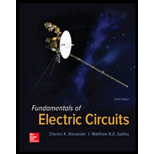
Concept explainers
(a)
Find the Inverse Fourier transform of
(a)
Answer to Problem 27P
The Inverse Fourier transform of
Explanation of Solution
Given data:
Calculation:
Consider
Substitute
Take partial fraction for the equation.
Where
Substitute
Similarly,
Substitute
Substitute
Substitute
Apply inverse Fourier transform on both sides of equation.
Conclusion:
Thus, the Inverse Fourier transform of
(b)
Find the Inverse Fourier transform of
(b)
Answer to Problem 27P
The Inverse Fourier transform of
Explanation of Solution
Given data:
Calculation:
Consider
Substitute
Take partial fraction for the equation.
Where
Substitute
Similarly,
Substitute
Substitute
Substitute
Apply inverse Fourier transform on both sides of equation.
Conclusion:
Thus, the Inverse Fourier transform of
(c)
Find the Inverse Fourier transform of
(c)
Answer to Problem 27P
The Inverse Fourier transform of
Explanation of Solution
Given data:
Calculation:
Modify equation (5) as follows.
Apply inverse transform on both sides of the equation.
Conclusion:
Thus, the Inverse Fourier transform of
(d)
Find the Inverse Fourier transform of
(d)
Answer to Problem 27P
The Inverse Fourier transform of
Explanation of Solution
Given data:
Formula used:
Consider the general form of inverse Fourier transform of
Calculation:
Modify equation (6) as follows.
Substitute
Conclusion:
Thus, the Inverse Fourier transform of
Want to see more full solutions like this?
Chapter 18 Solutions
Fundamentals of Electric Circuits
- Evaluate the Fourier transform, X(jω), of the following signal,x(t):arrow_forwardFind the inverse Fourier Transform of X(jω) = 1 / (4+ jω)^2 using convolution property.arrow_forward1. What is the mathematical expression for the given signal? 2. Determine the Fourier transform X(jΩ) of the signal x(t). Simplify your answer into one rational term.arrow_forward
- Regarding Signals and Systems, the Fourier Transformation of x(t) is given by X(jω)=F{x(t)}. The time duality property is X(jt)=2πx(-ω). My question is how do you go from x(t) to X(jt) and from x(-ω) to X(jω)? Thank you!arrow_forwardQ.) Evaluate the area under sinx/x between -inf and +inf (use known Fourier transform pairs, not integration)arrow_forward1.) Determine the discrete-time Fourier transform of the signal x[n]=(0.5)n−2u[n−1]. 2.) [see image]arrow_forward
- signal and systems, I need it ASAP please. Answer for b (A)Using the Fourier Integral, find the Fourier Transform of the following signal: f(t) = 1/2 * [delta(t + 10) + delta(t - 10)] (B)Using the Fourier Transform, integral, pairs and properties, evaluate: f(t)=cos(24t).sin(64t)arrow_forwardWhat is the Fourier transform of the following functions, and how fast do they decay? a) f(t) = {e-t, t>=0; 0, t<0} b)f(t) = {e-|t|, t>=0; 0, t<0}arrow_forwardFind the inverse Fourier transform of X(jω) = δ(ω−1) + δ(ω+1), and reduce the resulting expression to include a single cosine term. δ = delta functionarrow_forward
- Fast Fourier transform technique is used in the spectrum analyzers to determine/measure the lower order harmonics. True Falsearrow_forwardFind out the discrete time fourier transform of the signal y[n]=an u[n] where a<1.arrow_forwardLet a > 0, show that the Fourier transform of f (ax) is F (μ/a)/aarrow_forward
 Introductory Circuit Analysis (13th Edition)Electrical EngineeringISBN:9780133923605Author:Robert L. BoylestadPublisher:PEARSON
Introductory Circuit Analysis (13th Edition)Electrical EngineeringISBN:9780133923605Author:Robert L. BoylestadPublisher:PEARSON Delmar's Standard Textbook Of ElectricityElectrical EngineeringISBN:9781337900348Author:Stephen L. HermanPublisher:Cengage Learning
Delmar's Standard Textbook Of ElectricityElectrical EngineeringISBN:9781337900348Author:Stephen L. HermanPublisher:Cengage Learning Programmable Logic ControllersElectrical EngineeringISBN:9780073373843Author:Frank D. PetruzellaPublisher:McGraw-Hill Education
Programmable Logic ControllersElectrical EngineeringISBN:9780073373843Author:Frank D. PetruzellaPublisher:McGraw-Hill Education Fundamentals of Electric CircuitsElectrical EngineeringISBN:9780078028229Author:Charles K Alexander, Matthew SadikuPublisher:McGraw-Hill Education
Fundamentals of Electric CircuitsElectrical EngineeringISBN:9780078028229Author:Charles K Alexander, Matthew SadikuPublisher:McGraw-Hill Education Electric Circuits. (11th Edition)Electrical EngineeringISBN:9780134746968Author:James W. Nilsson, Susan RiedelPublisher:PEARSON
Electric Circuits. (11th Edition)Electrical EngineeringISBN:9780134746968Author:James W. Nilsson, Susan RiedelPublisher:PEARSON Engineering ElectromagneticsElectrical EngineeringISBN:9780078028151Author:Hayt, William H. (william Hart), Jr, BUCK, John A.Publisher:Mcgraw-hill Education,
Engineering ElectromagneticsElectrical EngineeringISBN:9780078028151Author:Hayt, William H. (william Hart), Jr, BUCK, John A.Publisher:Mcgraw-hill Education,





